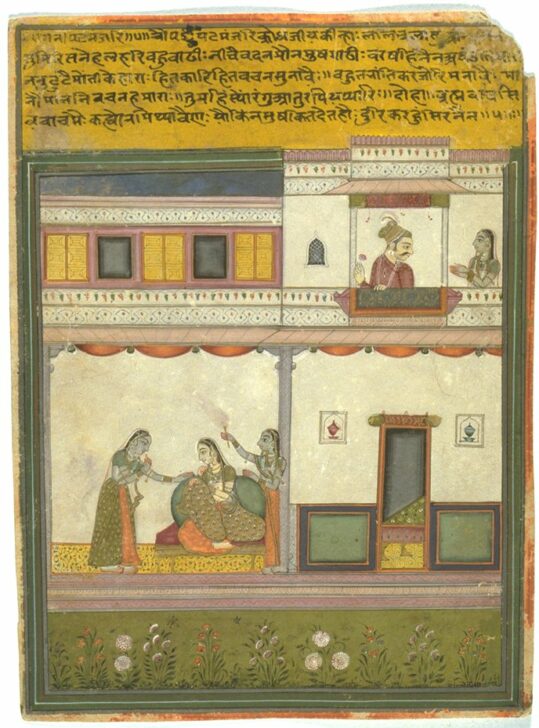Ragamala series: Ragini Patamanjari
Artist Unknown, India, Rajasthan, Jaipur School

Description
Jaipur School
Ragamala series: Ragini Patamanjari; Kukubha ragini;
Ragini Gujari
India, Rajasthan
ca. 1750
Ink, opaque watercolor, and gold on paper
Gift of Dr. and Mrs. Leo S. Figiel and Dr. and Mrs. Steven J. Figiel,
1975/2.161; 1975/2.153; 1975/2.157
Patamanjari ragini:
Caupayī: The embers of anger glow as her lover prepares to leave.
Reminded of his affection, she feels all the more mortified. She
casts her face down and is speechless, but she sheds torrents of
tears, as if a large necklace had broken and caused innumerable
beads to fall. Her lover thereupon addresses her sweetly and
showers affection upon her and pacifies her in various ways. He
assures her of his deep devotion.
Dohā: I cite the words of Lord Brahmā and Lord Śiva and do not
utter one word which is untrue. Oh, Lord Śiva, if you bestow
blessings upon mortals, please remove the anguish of my
beloved.
(translation by Stephen Markel)
Ragamala (meaning “garland of ragas”) paintings
were meant to evoke the same emotional
responses as ragas—short musical phrases that
formed the basis of Indian classical music and
were associated with a particular mood, season,
and time of day. Ragamala paintings would have
been mounted in albums, following the order
of the ragas, which were arranged into families,
headed by the “husband” raga and followed by
the “wife” ragini, and, occasionally, a variety of
children. These three images illustrate scenes
of love and lovesickness, a common theme in
Ragamala painting. They are in the Jaipur school
style, known for its vivid colors, idealized human
figures, and detailed, yet abbreviated landscapes.
The Ragamala paintings shown here include
both visual imagery and texts. The source of
the text is unknown, but versions of it appear
in many Ragamala paintings from this period.
Known as meditation aids (dhyāna-mantra),
these texts shed light on the main theme of the
images. Each is comprised of a rhyming quatrain
(caupayī) that describes the narrative shown in the
image, followed by a rhyming couplet (dohā) that
summarizes the meaning of the musical phrase,
the poem, and the image. The text is written in
Malvī, a subdialect spoken in central India around
Bundelkhand.
Subject Matter:
Ragamala paintings draw from aspects of human experience in order to visualize specific moods, emotions, and qualities such as love, anguish, valor, weakness, and strength. A raga in Indian music is a melody consisting of a string of notes in a particular arrangement. Raginis are derivations from or variations of ragas in feminine mode (the basis of these classifications remains unexplained in many cases), and could have different or similar musical structures as ragas. Specific ragas are associated with specific times of the day, seasons, and emotions. When visualized, as here, ragas and raginis are meant to evoke the same affective responses that are allied to their musical modes. The text above the illustration refers to stories or incidents associated with the depicted raga/ ragini, but may not necessarily be narrative-like or descriptive. Drawn from literary tropes and tales that sophisticated writers and viewers would be aware of, the inscriptions are an integral part of the overall experience of this miniature painting. An illiterate viewer, however, could still enjoy the scene without reading the text.
The Patmanjari ragini is a sad but beautiful melody, that stands to symoblize the anguish of a woman separated from her lover. In this image, the woman is shown as being reassured and attended to by her two servants, while the lover is depicted in a window above, removed from the action happening below. In this way, the painting alludes to the narrative of love and separation, further intensified by the atmosphere of night time loneliness and gloom.
Physical Description:
A female figure with her two attendants is shown in the bottom left of the image; a male figure appears in the window above, also accompanied by a female attendant who appears to be in conversation with him. The male holds a small flower in his hand--possibly a rose. The architectural space is divided skilfully, with distinct scenes or motifs taking place in each quadrant of the depicted scene.
Usage Rights:
If you are interested in using an image for a publication, please visit https://umma.umich.edu/request-image/ for more information and to fill out the online Image Rights and Reproductions Request Form.